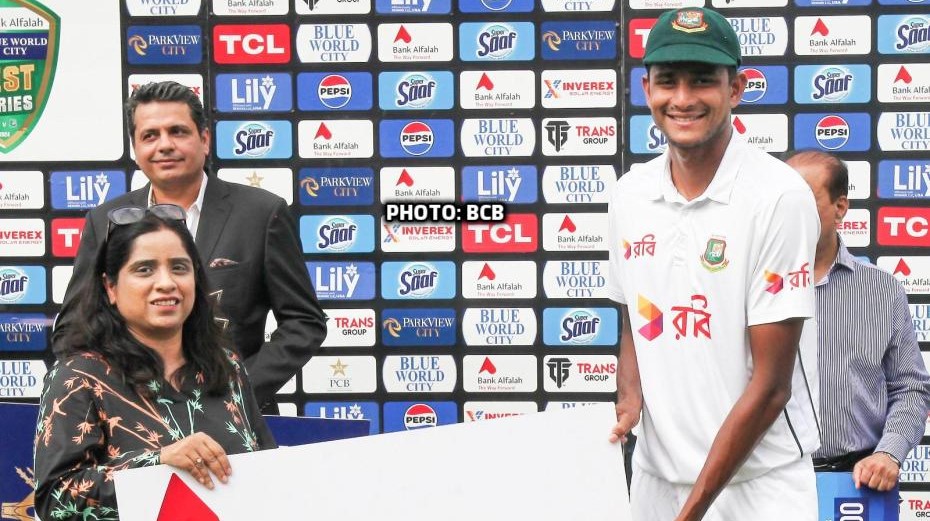Story
Brother's wish, Shoriful's help puts Nahid Rana on track
18 Sep, 2024
The young Bangladeshi pace sensation was carefully carved out by coach Alamgir Kabir, who also kept the promise he made to his elder brother; Mohammad Shoriful Islam acted as a guide while chipping in with help
 Bareera K.H.
Bareera K.H.
A young aspiring cricketer beginning to write
 Khurram Habib
Khurram Habib

Nahid Rana, the young Bangladeshi pace bowling sensation who rocked the Pakistani batting line-up in Rawalpindi last month, would not have strode on the cricket field had his coach Alamgir Kabir not promised to fulfil his older brother’s demand to have the youngster focus on education along with cricket.
Nahid’s father was a farmer and his older brother went to Saudi Arabia to work as a construction labourer to earn better and help improve the financial condition of the family. They have two sisters as well, both married now.
“Since no one in their family had completed a higher level of school education, 12th standard, Nahid’s brother wanted him to finish school. His brother made a rule that he will play cricket only if he completes his 12th class. The brother came to me and said, ‘Nobody in our family has studied at a higher level. We want him to get educated so that he doesn’t face any problem in future’. I told him that we will make him study and play,” said Alamgir to www.theflyslip.online.
Alamgir met him first in 2019 at the Clemon Cricket Academy in Rajshahi where he worked with Khaled Mashud.
“I saw him bowl very fast. He was 16. We made him play age group cricket. He was of thin frame, did not have much strength. But he used to bowl very fast. I liked that,” said Alamgir, who played Test cricket for Bangladesh in the early 2000s.
“We saw him with tennis ball and then gave him an old cricket ball. He was consistent with line and length.”
But there were some deficiencies in skill level.
“When he used to run in, he’d hold the ball in both his hands. I worked a bit on that though only slowly. We thought we’ll work on his skill only when he reaches at a higher level. We thought that if we work on it at that moment, his skill will suffer and his pace will reduce. He will struggle.
“Gradually he improved, we showed him his video too and he realised slowly where he was going wrong. He participated in local tournaments. We made him play as many matches as possible. We said the more you play, the better you will become. He is mentally strong, faced no problem.”
A brief halt hit his career during Covid.
Alamgir laments that the Bangladesh selectors didn’t give him an opportunity to play at the under-19 level, during the ICC U-19 World Cup in South Africa, where he was named only as a standby.
“But he persisted, played first-class cricket for Rajshahi Division, did well there and then in the Dhaka Premier League.”
Bangladesh, says Alamgir, had a “good tradition of fast bowlers”. However, due to pitches unfriendly to pace in domestic cricket, the pace bowling department began to suffer.
“What was happening in local cricket was that the conditions weren’t conducive to pace bowling. The pitches were either batting-friendly or only conducive to spin. Teams would play one pace bowler, an all-rounder and the rest would be spinners. That is why pace bowlers didn’t get exposure. We even used to start the innings with spinners.
“The BCB then stepped in about a decade ago in 2014-2015 and made a rule to feature a minimum of three pace bowlers in every game at age-group level. In 50-over cricket, pacers were supposed to bowl at least 20 overs in age-group cricket.”
In the longer format, BCB made a rule for pacers to bowl at least 40 overs out of the 90 bowled in a day.
“That helped the likes of Rana to emerge, bowling quick.”
Some help from Shoriful Islam
Among the more expensive equipment for a cricketer are the bowling spikes. An average shoe lasts about half a year, even less, for those who bowl continuously at top flight.
For Rana, help came through Mohammad Shorful Islam, the Bangladeshi international left-arm pace bowler.
“We used to show him Shoriful’s videos of training in the gym,” says Alamgir.
“Shoriful guides and helps him these days. Rana didn’t have a pair of good spikes because he wasn’t that well-off. Shoriful would give him a pair or two every year. Shoriful does that regularly for players who cannot afford the bowling footwear. Now that he is doing well, he himself has started gifting spikes to the needy players.”
Rana, 21, completed his school last year and has also earned scholarship from Bangladesh University, a private university in Dhaka.
Bangladesh cricket, Nahid Rana, India cricket, Chennai, World Test Championship, Alamgir Kabir